Special forces kill eight Somali pirates, capture five in the Indian Ocean
All of the 21 crewmembers of a South Korean freighter seized by Somali pirates armed with machine guns and rifles in the Indian Ocean last Saturday were safely rescued by South Korean troops, the Joint Chiefs of Staff said Friday.
The South Korean 58-year-old captain of the Samho Jewelry suffered abdominal gunshot wounds, but was not in critical condition, the JSC said. Eight pirates were shot dead and five others captured alive during the five-hour rescue operation.
South Korean special warfare troops of the Underwater Demolition Team suffered no casualties during the operation, codenamed “Operation Dawn in the Gulf of Aden.” The operation, which began at 9:58 a.m. on Friday, Korean time, occurred some 1,314 kilometers from Somalia.
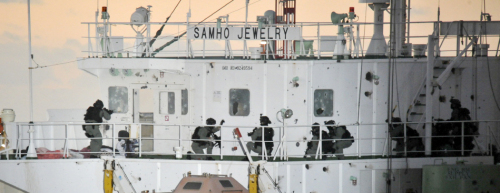 |
South Korean naval forces storm the steering room of the Samho Jewelry in the Indian Ocean on Friday. (Navy) |
The 11,500-ton freighter was carrying eight South Koreans, two Indonesians and 11 Myanmarese when it was captured in the Arabian Sea between Oman and India en route to Sri Lanka from the United Arab Emirates.
The Samho Jewelry and the destroyer Choi Young are now heading toward a safety zone ― a port in Salalah in Oman, officials said. They are expected to arrive at the port early next week.
It is the first time for South Korea to conduct a military rescue operation against Somali pirates targeting its citizens. The Samho Jewelry freighter was the eighth vessel carrying South Koreans to be captured by Somali pirates since a South Korean fishing vessel was captured in 2006.
The troops engaged in the operation against the pirates belong to the Cheonghae Unit, which was deployed in March 2009 to join an international anti-piracy campaign in the Gulf of Aden off the Somali coast. After the seizure, the unit sent its 4,500-ton destroyer Choi Young to the scene.
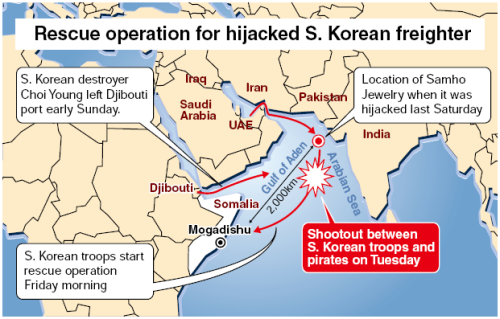
“The military operation showed our strong resolve not to tolerate any illegal activities by pirates targeting South Korean vessels,” said Lieut. Gen. Lee Sung-ho, director of the military operation support team at the JCS during a press conference.
“The situation was difficult as information was limited, and pirates and hostages were mixed together. Despite all this, we conducted a quick and bold operation with meticulous plans and preparation. This is a feat that recognizes our excellent operational capabilities.”
President Lee Myung-bak praised the South Korean troops for the successful rescue operation.
“Our military conducted a perfect operation under difficult circumstances. I praise and encourage them (for the successful operation),” said Lee during his speech at Cheong Wa Dae. “What is the most important for us is the life and safety of our citizens. We will not tolerate any action that threatens our citizens.”
Apparently to avoid leaving another “bad precedent,” the Seoul government had taken a tough stance, vowing not to negotiate with pirates and pay them any ransom.

Some critics here have argued that pirates have been emboldened and continued targeting South Korean vessels since the Samho Dream, a South Korean oil tanker seized last April and released 217 days later, was ransomed for $9.5 million ― the largest known payment following negotiations with Somali pirates.
During the rescue operation, South Korean troops continued to send a vocal message in Somali language that calls on pirates to surrender and fire warning shots, which might have worsened their psychological fatigue, officials said. The Combined Task Force-151, an international anti-piracy force, also assisted in the operation.
Three members of the Cheonghae unit also suffered minor injuries in a shootout with Somali pirates on Tuesday.
They were injured after they exchanged fire with the pirates as they tried to seize a passing vessel, which was Mongolian-administered.
None of them were in critical condition, officials said. During the firefight, at least six pirates died after a Lynx helicopter of the Cheonghae unit fired on them.
Of all the vessels carrying South Koreans to be captured by Somali pirates, the Geummi 305, a fishing vessel seized on Oct. 9, is the only one still being held captive. All the others except for the Samho Jewelry were released with ransom payments.
It has been increasingly challenging to crack down on Somali pirates as their methods have evolved and they have employed clever hijacking methods. They have new speed boats, GPS-equipped phones and an array of weapons including rifles and even anti-tank rockets.
The hijackers have also been emboldened by the absence of a functioning central government in their country, leaving them with no fear of punishment.
Somalia, with a coastline facing one of the world’s busiest shipping routes, has been in a state of civil war for two decades and has not had a functioning central administration since 1991.
A U.S.-led military intervention aimed at restoring order in Somalia began in December 1992. However, the efforts failed and international forces pulled out in 1995 due to the growing danger to troops.
According to data from the One Earth Future Foundation, a private non-profit organization dedicated to promoting peace through governance, over the past five years the amount of ransom paid to Somali pirates had increased from an average of $150,000 in 2005 to $5.4 million in 2010. At the end of 2010, approximately $238 million had been paid in ransom to Somali pirates in that year alone.
As of December, at least 27 vessels and more than 600 people are known to be held by Somali pirates.
By Song Sang-ho (
sshluck@heraldcorp.com)
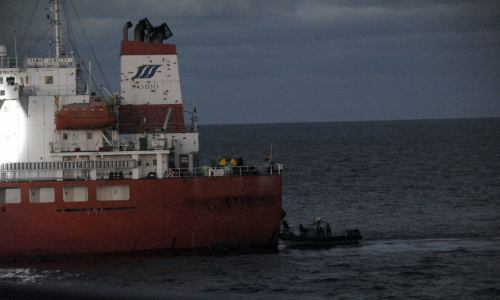
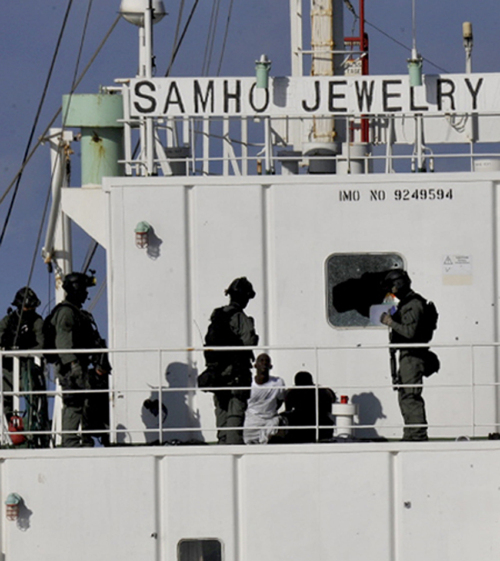
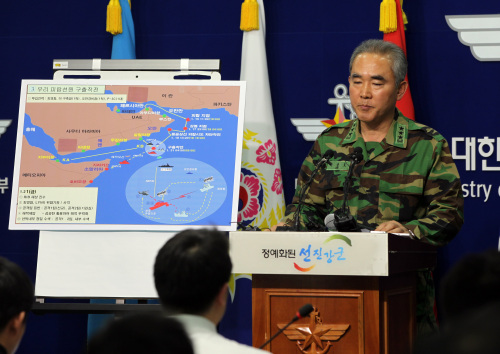 |
South Korea's defense official briefs on the raid of the Korean ship hijacked by Somali pirates on Friday. (Yonhap News) |













![[Today’s K-pop] Blackpink’s Jennie, Lisa invited to Coachella as solo acts](http://res.heraldm.com/phpwas/restmb_idxmake.php?idx=644&simg=/content/image/2024/11/21/20241121050099_0.jpg)